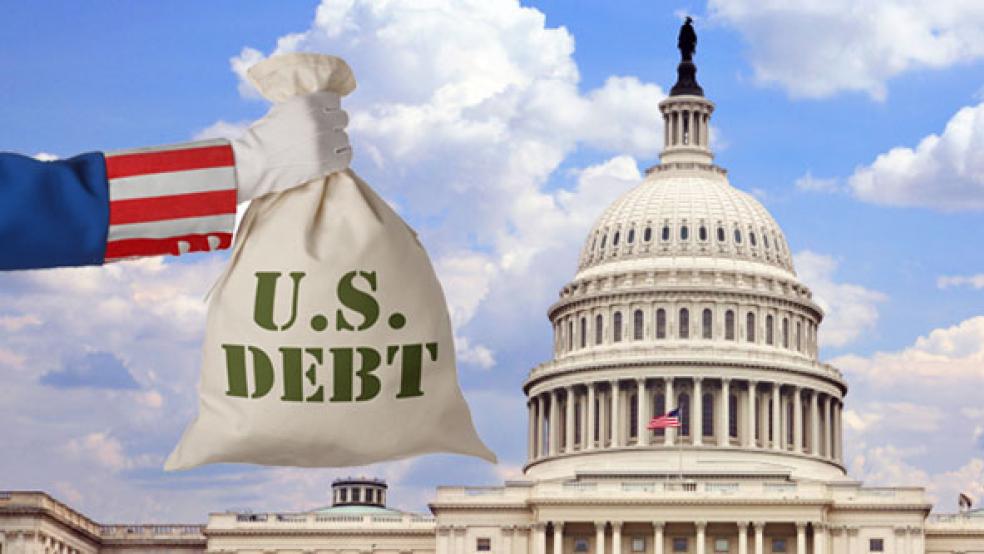Rejoice! The federal budget deficit continues to fall and likely will total just $506 billion by the end of the current fiscal year.
The economy’s gradual recovery from the 2007–2009 Great Recession, the waning budgetary effects of the stimulus and congressional tightening of federal spending have together reduced the deficit to its lowest level since 2007 – or roughly 3 percent of GDP, according to a new long-term budget analysis out Wednesday from the non-partisan Congressional Budget Office.
Related: 2014 Budget Deficit Will Fall to $492B: CBO
Senate Budget Committee Chair Patty Murray (WA), a prominent liberal Democrat, said today’s CBO report “is further evidence that our near-term budget outlook has improved significantly” and that “we should focus on tackling our other deficits in areas like education, jobs, infrastructure and research.”
But let’s not get too excited. As previous analyses by CBO, the Office of Management and Budget and independent budget watchdogs have cautioned, the decline in red ink after years of trillion-dollar deficits won’t last forever.
In the near-term, deficits will hover at a comfortable level of between 2.5 percent and 3 percent of gross domestic product from 2015 to 2018, according to CBO. That projection is premised on continued economic improvement and current budget policy prevailing – which is far from a sure bet.
Related: White House Touts Continued Decline in the Deficit
CBO today sharply reduced its 2014 projection of real growth of GDP to 1.5 percent, down from a February estimate of 3.1 percent. The budgetary agency said this reflects “the surprising economic weakness in the first half of the year.”
Beyond 2018, the budget outlook gets much gloomier, as the deficit begins to shoot up again.
The reason? “The pressures stemming from an aging population, rising health care costs, and an expansion of federal subsidies for health insurance would cause spending for some of the largest federal programs to increase relative to GDP,” according to the CBO analysis.
What’s more, current low interest rates will rebound and drive up the government’s cost of servicing its massive borrowing. “That additional spending would contribute to larger budget deficits—equaling close to 4 percent of GDP—toward the end of the 10-year period spanned by the baseline,” CBO stated. Taken together, annual deficits racked up over the next decade would total about $7.2 trillion.
Related: Want to Resurrect the Grand Bargain? Try Immigration Reform
That is more than the debt has grown since January 2009, at the start of the Obama administration, as the nation struggled to recover from the recession. The total government debt currently stands at $17.6 trillion.
Government debt as a percentage of GDP will hit 74.4 percent this year, the highest level since 1950, according to CBO. That percentage is expected to dip slightly but then begin to rise again in 2018, before hitting 77.2 percent in 2024.
As the population continues to age and makes increased demands on government services, federal spending will skyrocket to 26 percent of GDP by 2039, according to the CBO, compared to 21 percent in 2013 and an average of 20½ percent over the past 40 years.
Spending on Social Security, Medicare, Medicaid and Children’s Health Insurance, as well as subsidies for health insurance purchased through the Affordable Care Act, are on track to rise sharply to a total of 14 percent of GDP. That would be twice the 7 percent average seen over the past 40 years, CBO noted.
“How long the nation could sustain such growth in federal debt is impossible to predict with any confidence,” CBO concluded. “At some point, investors would begin to doubt the government’s willingness or ability to pay its debt obligations, which would require the government to pay much higher interest costs to borrow money. Such a fiscal crisis would present policymakers with extremely difficult choices and would probably have a substantial negative impact on the country.”
Top Reads from The Fiscal Times:
- 6 Reasons Obamacare Can Win the Senate for the GOP
- Want to Resurrect the Grand Bargain? Try Immigration Reform
- VA Watchdog Finds Outrageous Abuse, But No Direct Link to Deaths


